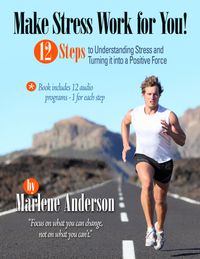Listen to this episode of the Focus with Marlene Podcast:
Get caught up with all episodes in the “Make Stress Work For You” series
Every day we get up, go to work, make meals, clean our houses, and try to unwind at the end of the day. We are adjusting to whatever demands are put on us.
When properly channeled, stress provides the energy and adaptability to live happy, energetic, and productive lives.
Each person responds to life differently.
What one person sees as overwhelming energizes another. Personality traits and our genetic predisposition play a role in how we perceive and respond to circumstances. But that does not mean we are locked into only one way of responding to life’s challenges.
When we recognize and understand what creates a negative stress response for us, we can alter our approach and put that stress to work for us instead of against us.
We were designed to deal with all kinds of challenges.
Things in our environment can become stressful: a hot day, irritating noise, pollution, kids that won’t behave, ongoing conflict in our marriage, work that never gets done, etc.
Physical impairments, chronic illness and pain can all put additional demands on our stress system.
Yet, we see people with disabilities often handling their problems more effectively than us who may be more physically strong and capable. What makes the difference?
Someone I knew had severe food allergies, but it never stopped her from attending social events. She just brought her own food. Most of the time people weren’t even aware of it. She never made a big deal of it.
I know people who have lost limbs, or were born without arms and legs, who have lived happy and productive lives. We see soldiers who have returned from the battlefield with missing limbs who are out there doing impossible feats, even participating in races. They have acknowledged and accepted those additional stressors, adjusted and live productive lives.
My son was born without the muscles to hold up his head, yet he learned to walk, run and play in a brace, had surgeries, performed in school plays, traveled overseas, and made a living with his artistic talents. He never lost his sense of humor or the twinkle in his eye.
There will be times when the stressors are overwhelming.
The more stressful life events a person experiences at any one time, the more stress they will experience. But we do not have to stay in that spot forever. Stress can become cumulative and the demand to adjust and adapt becomes greater. But even then, we can find constructive ways to deal with it.
What makes the difference between destructive stress and stress we meet as a challenge is how we respond.
When we remain overloaded and fatigued for longer and longer periods of time, without the ability to recuperate, we will begin to show signs of distress, both internally and externally.
When we continue to worry for longer and longer periods of time, focusing on everything that could or is going wrong, we set ourselves up for anxiety. We no longer look for productive ways to adapt but remain constantly geared up without a place to put that energy.
Recognize your stress signals.
Listen to your body. Is it telling you to take a break and rest? Are you able to go to sleep and sleep through the night?
Listen to your feelings. When we experience fewer moments of enjoyment, relaxation, and fun, we find ourselves feeling more depressed, fearful and anxious.
Listen to your spirit. Apathy, cynicism, and loss of meaning for life are all symptoms of stress overload. Cynicism is one of the highest risks for stress-related health problems.
Look at your relationships. When conflicts are the norm, check out your attitude, expectations, assumptions, rigid rules and listening skills.
As we become aware of the things that create unwanted stress in our lives, we can learn methods and skills to change them.
 My book, Make Stress Work for You! 12 Steps to Understanding Stress and Turning it into a Positive Force, contains information on how to recognize your stressors so you can change your responses.
My book, Make Stress Work for You! 12 Steps to Understanding Stress and Turning it into a Positive Force, contains information on how to recognize your stressors so you can change your responses.
Get the ebook, audio recordings, study guide, and four bonus resources for only $19.99.


